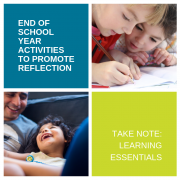End of School Year Activities to Promote Reflection
The end of the school year brings a lot of excitement. It is a time for celebrating students’ growth, achievements, perseverance, and accomplishments. While students often spend those last few weeks of school looking ahead—to summer, to vacations, to the next step in their education— teachers will find it beneficial to encourage students to look back on their year and reflect.
Reflection as a process
To reflect on something, in the general sense, means to look back on and consider a past occurrence. However, in the educational realm, reflection can be more of a structured process.
A student:
1) learns something or absorbs information,
2) assesses prior knowledge of the topic,
3) considers the new information,
4) uses or practices the new skill or information, and then
5) examines how he or she can utilize the skill/info for further learning and growth.
With this cyclical process in mind, teachers can promote contemplation and metacognition at the end of the year by asking students to ponder what they have learned, revisit the difficult moments/skills, make connections to how this knowledge can serve them in the future, and consider additional learning opportunities.
Benefits of reflective practices
- Reflection promotes retroactive problem-solving skills. Students have an opportunity to look back on their work and consider in what other ways they could have approached a task or completed a project. If forces them to examine the steps that they took and how they could improve on that same task the next time.
- Reflection gives students a stronger sense of responsibility and ownership over their work. By revisiting completed work or writing from earlier in the year, students are reminded of the fact that, while they earn a grade from the teacher, every decision that they make regarding an assignment is what contributes to that grade—they hold the keys to their success or failure.
- They get to know themselves as learners when examining their academic strengths and weaknesses. This level of self-examination encourages students to capitalize on their strong points and consider how they can improve on their weaker areas.
- Reflection also promotes creativity. During the process, students consider alternate ways that a goal or task could have been accomplished. In asking themselves how they would approach a similar task next time based on what they know now, students automatically brainstorm new approaches, strategies, and techniques to expand their understanding for the next opportunity.
Activities to try
- Ask students to evaluate the class using a Google form: What was interesting, boring, repetitive, beneficial, etc.? What improvements would they like to see if they had to complete the class over again? What advice would they offer to next year’s students? What unit, project, or topic was the most enlightening? What information or knowledge will they be most likely to take with them moving forward through their education?
- Ask students to use Padlet or another form of whole group sharing platform to provide advice for future students.
- Use a day of class to host the “Academy (Academic) Awards” in which students are recognized for their various strengths: BEST PUNCTUALITY, BEST PARTICIPATOR, BIGGEST HELPER, BEST QUESTIONS, BEST CREATIVE INFLUENCE, etc.
- Make a Rose & Thorn or top 10 list. Ask students to consider their best memories or experiences during the school year. Encourage them to talk about what made that memory great.
- Portfolios, especially for arts and English courses, allow students to have a physical “scrapbook” of their progress and achievements from throughout the year. For teachers, this will take a little bit of prep work early on, but the data that can be gathered from these portfolios is beneficial to our own professional growth and reflection as well!




